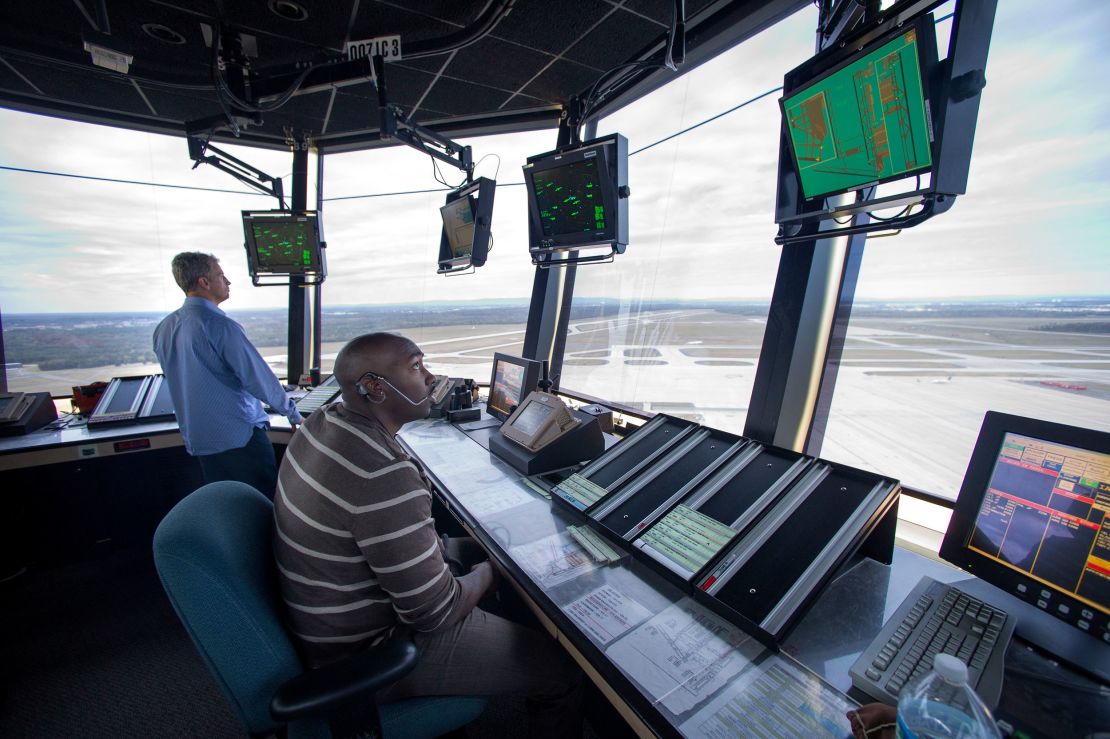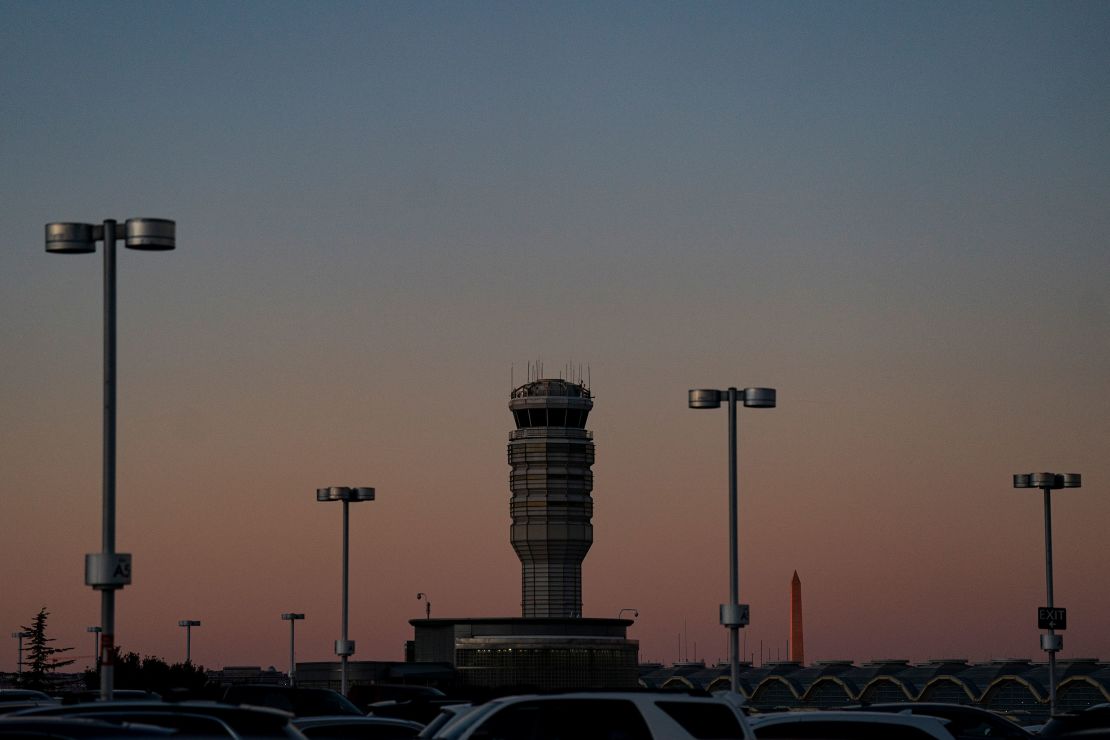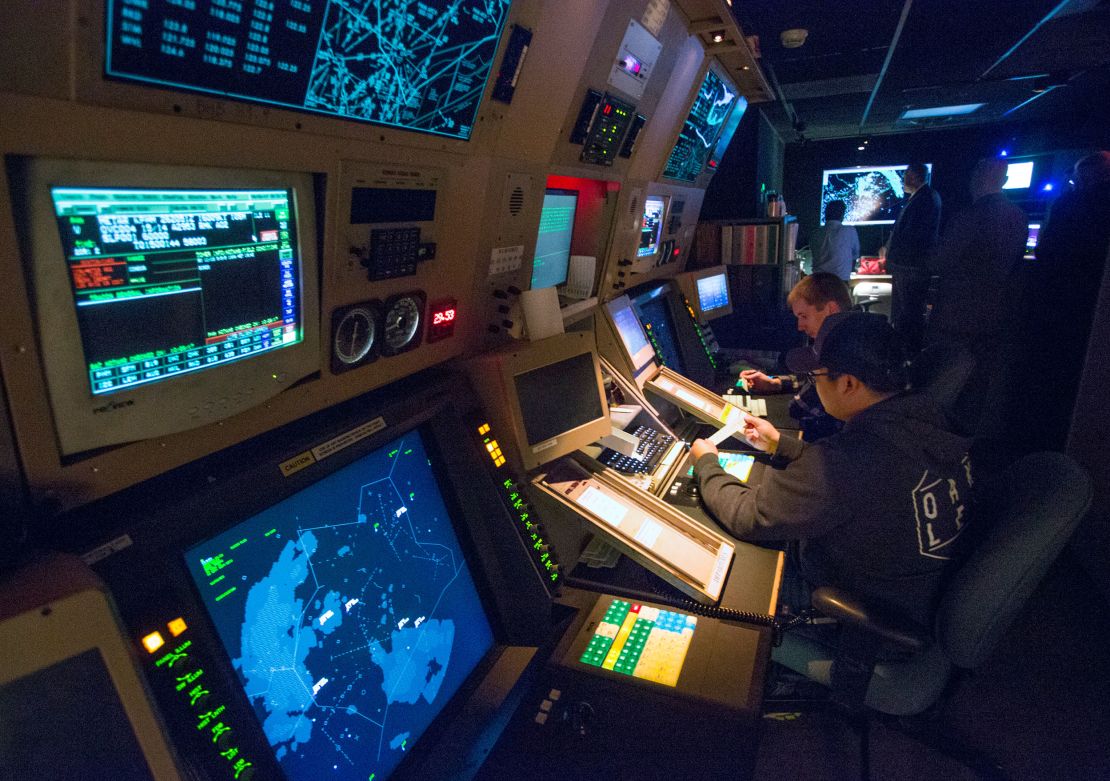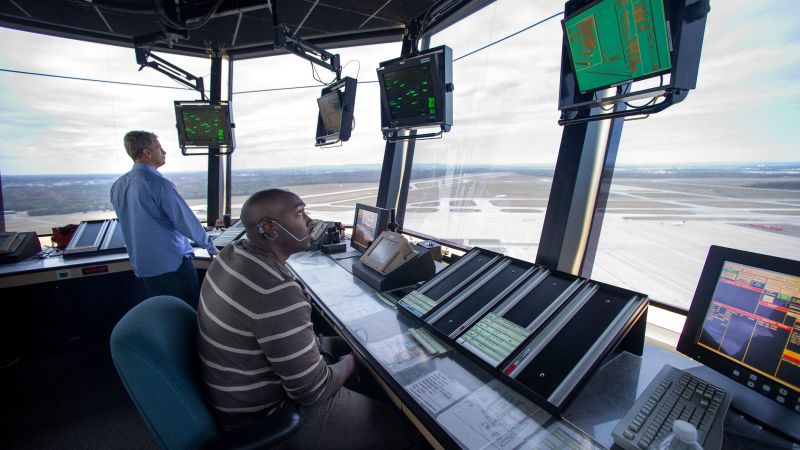CNN
—
Every day, millions of travelers’ lives are literally up in the air, relying on the acuity of air traffic controllers to orchestrate high-speed maneuvers and help prevent aircraft from crashing.
But the shortage of air traffic controllers is nearly the worst in 30 years, said the National Air Traffic Controllers Association, which represents 10,800 certified ATCs across the country.
The shortfall has forced many to work “six days a week, 10 hours a day – for years at a time,” union President Nick Daniels testified at a House subcommittee hearing this week.
The US needs more than 3,000 new air traffic controllers to reach adequate staffing, he said. And recent, high-profile incidents have highlighted the scarcity and workload of exhausted air traffic controllers.
“What is new – or more problematic or more common now – is the use of overtime,” said Michael McCormick, a professor and air traffic management coordinator at Embry-Riddle Aeronautical University.
“I would say your larger facilities are probably more problematic in use of overtime than the smaller facilities – just where you don’t want it the most.”
In January, a commercial jet and a military helicopter collided midair near Ronald Reagan Washington National Airport, killing 67 people. While authorities have not identified the cause of that catastrophe, CNN has confirmed one air traffic controller was staffing two different jobs in the tower – handling both local air traffic and helicopter traffic in the area.
And investigators recently said a near collision in 2023 was caused by an air traffic controller who was distracted by a third plane, though their report did not explicitly cite staffing shortage or exhaustion.
The federal government recently announced pay boosts for new air traffic controllers and more efficient hiring processes. But anyone over age 31 is too old to apply, limiting the hiring pool. And the vast majority of controllers are forced to leave their jobs a decade before standard retirement age.
Air traffic control applicants must be less than 31 years old so they can work the mandatory 20 or 25 years needed to qualify for pensions before their mandatory retirement age of 56, an FAA spokesperson said.
While that age cutoff might seem young, ATCs must have incredible physical stamina and mental sharpness, McCormick said.

“When you first start at an air traffic control facility, you have to do a lot of memorization,” McCormick said.
“You have to memorize what’s known as the radar map. You have to know what every single dot dashed line means on the map. You have to memorize how the airspace is sectorized. So think of Tetris. There’s multiple layers and shapes that all fit together into a puzzle. That’s what airspace is like, too.”
But this Tetris-style puzzle is “in three dimensions. So you have to memorize the geographical confines of all the sectors and the altitude limitations,” McCormick said.
Most air traffic controllers don’t just monitor one airport. Many keep tabs on dozens of other regional airports to make sure planes keep a safe distance from each other.
At Philadelphia’s main airport, “there’s also 72 satellite airports in the airspace that you also have to know,” said McCormick, who worked in that airport’s traffic control tower.
“You provide approach control services (to) all those airports, too. So all that needs to be memorized … you can’t waste time and energy looking something up or trying to remember something.”
The cognitive challenges intensify with age and when air traffic controllers move to larger airports – forcing them to memorize significantly more data and track more regional airports, McCormick said.
The head of the Department of Government Efficiency, Elon Musk, has touted slashing government jobs in an array of departments. But he recently asked retired air traffic controllers to consider returning to work.
“There is a shortage of top notch air traffic controllers,” Musk posted on X. “If you have retired, but are open to returning to work, please consider doing so.”
But it’s unlikely retirees will return to control towers because of a federal law requiring air traffic controllers to retire by age 56.
In rare cases, ATCs can get one-year waivers to keep working up to age 60, if they show strong mental and physical ability, McCormick said. And ATCs can still work elsewhere after their mandated retirement from air traffic control.
But many choose to retire by age 56 – if not earlier – due to generous pensions, McCormick said.
“Unlike traditional federal employees that need 30 years of service to retire, air traffic controllers are able to retire at age 50 with at least 20 years of service or any age with at least 25 years,” the FAA said.
“Retirement annuity is a guaranteed income for a person during their retirement years. Air traffic controllers receive a more generous annuity than traditional federal employees.”

But given the dearth of air traffic controllers, McCormick recommends studying whether it’d be safe to raise the mandatory retirement age to allow those who are still mentally and physically sharp to work beyond age 56 if they want to do so.
“There needs to be funded research on ‘is that mandatory retirement age still valid?’ Because that has been in place since the 1970s,” McCormick said.
“And since that time, there has never been any effort to validate: Is that good? Is it not good? Has the aging process changed over time?”
Since new hires often require years of training, “if you can extend people who are eligible to retire (by) one to five years, that gives a chance for the FAA to build their workforce back up,” McCormick said.
The US Department of Transportation has not responded to why the specific age of 56 was chosen or whether it is considering adjusting the age limits.
Stringent requirements and high attrition
The scarcity of air traffic controllers isn’t due to a lack of applicants. It’s the lack of qualified applicants who meet the FAA’s rigorous requirements.
“Less than 10% of all applicants meet these requirements and are accepted into the training program,” the FAA said.

Some applicants don’t pass the medical and security clearances. And many don’t make it through the strenuous academy and training.
“It’s a rigorous training process,” Daniels told CNN last month. “So it’s not like today we could go out and hire the 3,600. It takes two to three years to get a controller from being qualified … just to enter the job.”
After that, there are “multiple points where they can fail out of being an air traffic controller – everything from academy to simulation training locally and then eventually talking to aircraft on their own.”
With the current staffing deficit, about 41% of air traffic controllers must work 60-hour weeks, the union said.
The mandatory rest period between shifts has increased from eight hours to 10 hours – though that includes time to commute home.
But there are no mandates requiring two days off at the end of work weeks, meaning many ATCs have only a 24-hour weekend before starting another work week.
While controllers get extra pay for mandatory overtime, grueling 60-hour work weeks can fuel attrition. And the longer the staffing shortages persist, the longer some ATCs risk exhaustion and burnout.
“The past hiring rate was not keeping up with the natural attrition of workers leaving the profession due to retirement or other stresses of the job,” said Galen Munroe, a spokesperson for the ATC union.
McCormick attributes the ongoing shortfall to the “inability to hire and train controllers due to things like Covid, the recession, government shutdowns.”
The number of air traffic controllers started plummeting around 2013, after a government shutdown, McCormick said.

Since then, every time the government has shut down, training and hiring for air traffic controllers have come to a screeching halt. Recruits at the FAA’s training academy in Oklahoma City must be sent home.
Now, experts worry a potential government shutdown on March 14 will exacerbate the shortage.
“If there’s a government shutdown on March 14th, it’s going to make a mess of our hiring and training and control,” McCormick said.
Pay bumps and expedited hiring
To combat the shortfall, Transportation Secretary Sean Duffy announced “a new plan to supercharge the hiring of air traffic controllers.”
The current hiring window is open through March 17, “and we are making it more efficient than ever to apply and more affordable to begin training,” the FAA said.
The starting pay during academy training will jump from $17.61 an hour to $22.61, the agency said. “Pay continues to increase as you gain more experience and earn professional certifications,” the FAA said.
“Within three years of graduating the Academy, the average certified professional controller earns over $160,000 per year.”
And the old, eight-step hiring process that can last well over a year is being replaced with a faster, five-step hiring method. For example, the FAA can now work to process medical and security clearances at the same time, rather than waiting for one to finish before starting the other.
The streamlined process “will accelerate the time-to-hire for these critical positions by shaving more than four months off the old process.”
The FAA said it has already made gains in the past year, exceeding its goal of hiring 1,800 air traffic controllers in 2024 – the highest number in nearly a decade.
McCormick said the FAA could go further to get young people interested in becoming air traffic controllers.
“I think they need to start reaching out more to high school age (students) and do heavier recruiting at a younger age,” he said.
But the ongoing shortfall – and never-ending attrition – mean the problem won’t be solved quickly.
“It’s going to take time,” he said. “It’s going to take years to fill that gap.”
CNN’s Chris Isidore, Alexandra Skores and Alta Spells contributed to this report.

